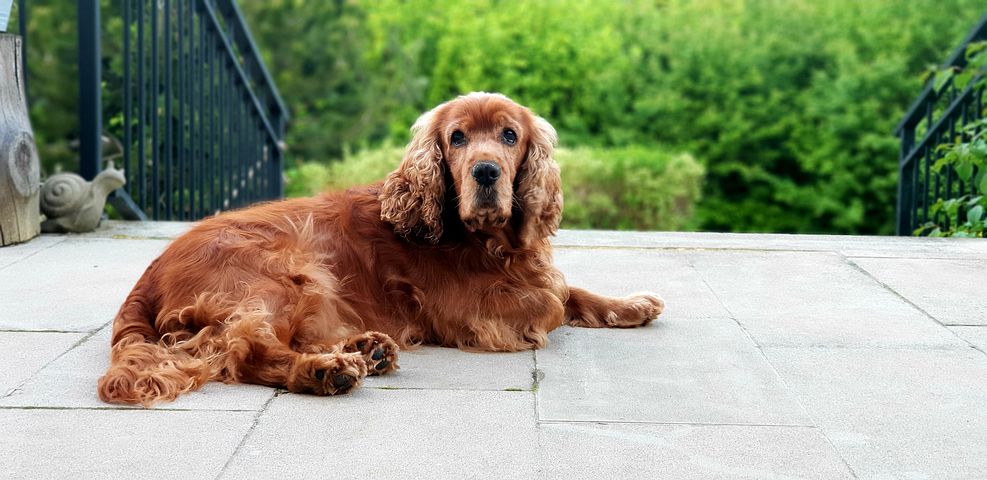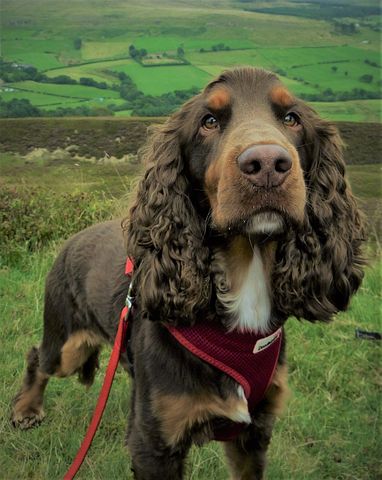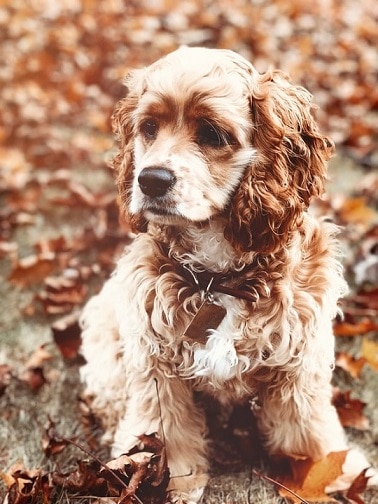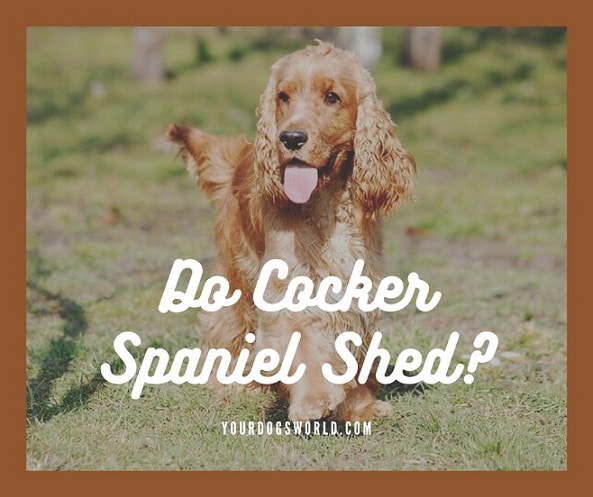The Cocker Spaniel is an intelligent, loving, and loyal dog. They come in attractive coats and colors which makes them the perfect companion dogs for any American household.
Dog lovers who wish to own this dog usually have one question. Do Cocker Spaniels shed?
Yes, Cocker Spaniels do shed. They shed on average. And they are neither hypoallergenic like Poodles nor are heavy shedders like Corgis.
These dogs have delicate coats that need to be brushed. The intensity of grooming would depend on the shedding rate and coat character of a Cocker Spaniel.
The Cocker Spaniel have double coats, they also tend to shed more during the shedding season.

Why do Cocker Spaniels shed?
All dogs shed their hair to a certain extent. Some shed less and some shed more.
Shedding helps to naturally eliminate old and damaged hair. Old hair must be removed to make room for new healthier hair.
In some cases, shedding also helps to regulate the body temperature to suit the season. This is true for dogs like the Cocker Spaniel who “blow” their coat before summer and fall seasons.
Coat characteristics of Cocker Spaniel
The Cocker Spaniels have long to medium hair. This hair coat can feature a curly or straight appearance depending on the parent genes.
The texture of this dog breed hair coat is prone to becoming matted and tangled. Even if you skip grooming for two or three days, you can have a lot of tangles to take care of! As his owner, we strongly advise you to be regular.
Types of Coat
The Cocker Spaniels have a double-coat that consists of two layers that serve different purposes.
Double coat dogs tend to shed more hair, than a single coat dog. For this reason, you can expect medium shedding, but high grooming demands.
Under coat
This is the dense underlying hair coat that functions to keep cold air and water out. It protects the delicate skin of the Spaniel. This coat is made of short hairs and may not be visible.
Top coat
This colorful attractive coat is longer than the undercoat. It can be of several types; smooth, rough, silky, or feathery. The texture and length of this coat have little effect on shedding pattern or density.
These long hairs also continue down to the legs, ears, and the rest of the body.

Cocker Spaniel coat colors
The Spaniel comes in a vast array of colors that they inherit from their parents. These usually sport a single color on their coat but multiple colors are also seen sometimes.
Let us have a look below on the several colors their coats can take on.
Tan- Light sand brown can appear as a full coat color or it can appear as markings. These markings are usually present on the limbs, face, ears, and the belly (sometimes). The ears and face can exhibit a darker tan color than the rest of the body.
White- Most American households are open to the idea of an all-white dog. This is probably the reason the white Cocker Spaniel is a common occurrence in the USA. This is one of the best colors if you can keep your dog indoors.
Cream- Cream or off-white makes an appealing look that suits the curly hair tufts of the Spaniel. It is an intermediate mix of white with tan. If you prefer light colors other than white, you can opt for a cream Cocker Spaniel to complete your home.
Roan- Roan is a unique pattern in the Cocker Spaniel coat. It is a mixture of white hair that is mixed with colored hair. The result is a dark background colored coat that is lightened with white hair. This gives a dual-tone appearance to the coat.
- Red roan- Red roan is a combination of red hair that is completed with white hair as well. The result is undeniably beautiful as the coat appears ginger or orange. Any dog owner would be proud to own a red roan Cocker Spaniel dog.
- Blue roan- Likewise, the blue roan is also an impressive dog hair coat color option. It is not actually blue hair but black hair that appears blue when white is fused with it. In the English Cocker Spaniel, blue roan is the most popular color.
Black- Black is a color commonly seen in Cocker Spaniels. The hair coat could be all black or feature tan points across various parts of the body. It perfectly breaks the black and creates a color contrast that is pleasing to the eye.
Types of shedding
Shedding is a normal activity but it is important to know when it is caused by stress or a medical condition.
Natural shedding
All dogs display the natural cycle of hair growth. In this cycle old hair breaks or falls out and is replaced by new hair. This shedding occurs throughout the year at a uniform rate.
The Cocker Spaniel undercoat is there to keep him warm during winter, it makes sense to get rid of it for summer. Therefore, dogs tend to shed more in the spring and fall seasons. It is an adaption to manage the temperature of the body.
Shedding due to medical reasons
Like humans, the Cocker Spaniel may develop hypothyroidism which could lessen their fur.
Other skin problems and allergies could also cause your dog to shed. Food that lacks the essential vitamins and nutrients for your dog, can also cause your pooch to shed.
Some Cocker Spaniel dogs may become very attached to their families. Sometimes, when they are left alone at home, it can cause anxiety issues leading to shedding.
As you can see there are a host of reasons that your Cocker Spaniel might be shedding. However, if you still feel that your dog is still shedding above normal, it is best that you consult a vet.
Looking for Hypoallergenic dogs – https://yourdogsworld.com/b/dogs-that-do-not-shed/
Cocker Spaniel Grooming
Here lies the test of your love for your Cocker Spaniel, Grooming! They need to be groomed every other day.
If they have gone out for walks in rough terrain, give them a brush. This helps to untangle their hair, and remove any grass or weeds that may have become stuck to them.
Trim any hair that has grown too long at their feet. This trimming helps to keep them walking properly and avoid any objects becoming tangled and attaching themselves to their feet.
Combing your dog’s hair regularly also ensures that you do not have hair falling all over your home. Better to catch the hair before the sofa does! This will reduce household cleaning and save valuable time.
Without a rigid grooming schedule, the Spaniel coat could become matted and tangled, so make sure you commit to this before adopting a Cocker Spaniel.
Grooming Tips for Cocker Spaniel
Grooming your dog is the first step to managing shedding. You should brush their hair with a good quality brush.
- Try to brush them slowly and carefully so that you do not break their hairs. If you make it an unpleasant experience, your dog will hide when it is grooming time. This is the last thing you want.
- When bathing your dog, get a good quality shampoo, that will not irritate your dog’s skin. Gently, massage the shampoo into the fur coat to dislodge dirt and loose hair. Bathing also helps to untangle the coat.
- When bathing your dog, you could use a blow dryer on a low setting to dry the hair. An even better option is to let them do it themselves outdoors. They will run at high speed and rub against anything to dry themselves.
- Take care to dry the ears, and check inside if the ears are dry and clean. The Cocker Spaniels are prone to ear infections as the ears hang down and do not get aerated.
- Bath time is also a good time to examine your dog for any swellings, cuts, or other injuries. These injuries should be treated to avoid them becoming infected.
Keeping the house free of Cocker Spaniel hair shed
A house free of hair and curls of fluff is what every dog owner aims for. Sadly, this is easier said than done. To help you out, here are some tips to keep the house clean.
- Microfiber cloths are great because they attract and collect dog hair. They are also great for wiping allergenic substances such as dog saliva and dander.
- Lint roller brushes are a great way to make sure you get all the dog hair off your clothes before you go to work.
- A vacuum cleaner will be necessary if you want to get all the hair and dander out of the carpet. Carpets and mats are places where dog hair collects, fast!
- Furniture brushes help to remove hair that has accumulated over soft furnishings. This is ideal for chair seats, couches, and curtains.
About Cocker Spaniel
Cocker Spaniels were used as hunting dogs in the past, today they are popular companion dogs throughout the world, especially in the USA. They are also used in dog shows as they are bright and attractive dogs.
Types of Cocker Spaniels
The Cocker Spaniel dog breed can broadly be divided into two types, these are the American Cocker Spaniel and the English Cocker Spaniel.
Here are the differences between the two dogs which sometimes confuses people.
American Cocker Spaniel
- Their bodies are shorter
- They have shorter coats
- Short necks
English Cocker Spaniel
- They are slightly taller
- Coats are longer
- Longer necks

Appearance
They have strong bodies and well-developed muscular legs, derived from their hunting dog ancestors.
Their eyes are full of expression, round coffee or hazel coloured eyes give them an innocent look. Their ears are long and droopy, with long straight hair that feels like silk when perfectly brushed.
It is not hard to see why this canine inspired the movie “Lady and the Tramp”.
Temperament
Even though they originated in Spain, the Cocker Spaniel has become one of the most popular American purebred dogs.
The Cocker Spaniel is a very happy, gentle, loving, and quiet dog. They are fantastic with children and you will not have to worry about any accidents.
They are very smart and training them will not be a burden. They are sometimes nervous and should be gently handled in training. Use as many stimulating techniques with rewards to dispel these nerves.
They should be socialized at an early age to give them confidence and avoid any stubbornness you might encounter. These dogs need a lot of love and care to bring out the best in them.

